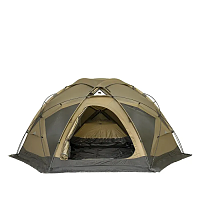Cart
Loadding...
Weathering the Elements: How Tipi Tents Stand Strong in Harsh Conditions
Dec 29, 2023
When it comes to outdoor camping, having a reliable and sturdy shelter is crucial, especially in harsh weather conditions. Tipi tents, also known as teepee tents, have stood the test of time as traditional shelters that offer exceptional protection against wind, rain, and snow. In this blog post, we will explore the unique features and advantages of tipi tents that make them an excellent choice for weathering the elements during your camping adventures.
1. History and Design of Tipi Tents:
Tipi tents have a rich history that dates back centuries and were traditionally used by Native American tribes. The design of a tipi tent consists of a conical shape with a single center pole and a smoke hole at the top, allowing for efficient ventilation and smoke dispersal when using a stove inside. This design not only provides stability against strong winds but also ensures proper airflow, minimizing condensation and maintaining a comfortable interior environment.
2. High-Quality Materials:
Modern tipi tents, such as those offered by POMOLY, are constructed using high-strength Oxford cloth and high-grade waterproof materials. These materials, including seams and glued areas, are designed to withstand the harshest weather conditions. The use of durable fabrics ensures that the tent remains waterproof, keeping you dry and comfortable during rain or snowfall.
3. All-Season Performance:
One of the key advantages of tipi tents is their versatility in various seasons. Whether you're camping in the summer, winter, or any other time of the year, tipi tents are designed to accommodate your needs. With the addition of a stove jack, you can safely use a tent stove inside the tipi, providing warmth and comfort during cold winter nights. The stove jack allows for the safe passage of the stovepipe through the tent fabric, ensuring proper ventilation and preventing any fire hazards.
4. Space Efficiency and Interior Design:
Tipi tents are known for their efficient use of space. The conical shape maximizes the interior space, allowing for comfortable sleeping arrangements and storage of camping gear. Additionally, tipi tents often come with a half inner tent, providing privacy and separation from the outer elements. The inner tent creates a cozy sleeping area, while the remaining space can be utilized for storing equipment or engaging in other activities.
5. Easy Setup and Portability:
Setting up a tipi tent is a relatively straightforward process, even for beginners. The single center pole serves as the main support, and the surrounding fabric is secured using stakes or guy lines. This simple setup allows you to quickly assemble the tent and start enjoying your camping experience. Moreover, tipi tents are designed to be lightweight and compact, making them easy to carry and transport to different camping locations.
6. Durability and Longevity:
Investing in a high-quality tipi tent ensures its durability and longevity. The use of robust materials, reinforced stitching, and thoughtful design contribute to the tent's ability to withstand the elements for extended periods. Tipi tents are built to last, providing reliable shelter year after year, making them a cost-effective choice in the long run.
7. Tips for Maximizing Tipi Tent Performance:
To fully optimize your tipi tent's performance in harsh conditions, here are some valuable tips to keep in mind:
a. Proper Staking and Guy Lines: Ensure that the tent is properly staked and the guy lines are securely anchored to provide stability against strong winds.
b. Ventilation Management: Proper ventilation is essential to prevent condensation inside the tent. Utilize the smoke hole and properly adjust the stovepipe to maintain adequate airflow.
c. Seam Sealing: Before your camping trip, it is recommended to seal the seams of your tipi tent to enhance its waterproof capabilities. This simple step can significantly improve the tent's performance during rainfall.
d. Site Selection: Choose a suitable campsite that offers natural windbreaks, such as trees or rock formations, to provide additional protection against strong gusts of wind.
e. Regular Maintenance: Inspect your tipi tent regularly, checking for any signs of wear and tear. Repair or replace damaged components to ensure the tent's continued performance and longevity.
Conclusion:
Tipi tents have proven their resilience and reliability in withstanding harsh weather conditions, making them an ideal shelter choice for outdoor camping enthusiasts. With their historical significance, thoughtful design, and use of high-quality materials, tipi tents provide excellent protection against wind, rain, and snow. Whether you're camping in the summer or braving the winter cold, a tipi tent will offer a comfortable and secure haven in the great outdoors. So, embrace the elements and embark on unforgettable camping adventures with a tipi tent as your trusted shelter.
- Contact Us
-

About Pomoly
Pomoly is a leading camping brand specializing in hot tents and tent stoves. We are camping life explorer, Follow Page / Join Group, let's make camping enjoyful together!
Working Hours
Mon-Fri, 09:00 - 17:00

- Company Info
- NEWS
- About us
- Pomoly Name
- Leave-No-Trace
- Contact Now
- Facebook Group
- YouTube Learning
- Contact Us
- Topic Collections
- Policies & Terms
- Payment Policy
- Shipping Policy
- Return & Refund
- Privacy Policy
- Terms of Use
- Tax Policy
- Website Disclaimer
- Safety Disclaimer
- Warranty Policy
- Promotion Policy
- Pre-order Policy
- INTELLECTUAL PROPERTY RIGHTS
- Dealers Agreement And Terms
- Become Affiliate
- User Center
- Forget Password
- My Orders
- Tracking Order
- My Account
- Register
- Popular Searches
-
Tipi Tents Dome Tents Camping Tent Hammock Stove Camping Camping Pellet Stove Circle 6 Titanium Water TankDome X Locomotive 20 LEO 2 camping tent T-Brick 2.0 T1 2.0 tent stove Dweller wood stove Oroqen 2.0 Chimney Water Tank Lumberjack STOVEHUT Bromance 70 Tipi Pomoly Coupon Baker Oven Stove Titanium elbow Fire Pits Tent Stove titanium Stove Outdoor Pellet Stove
keebon pellet stove






